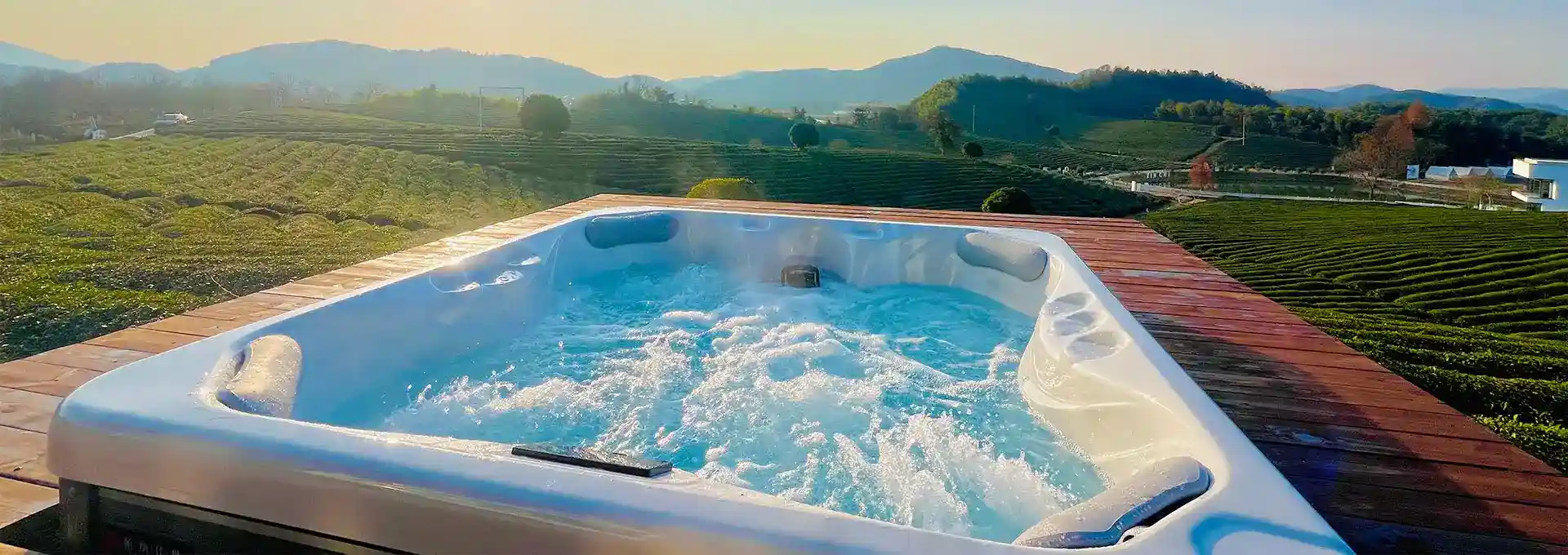How to Cool Down a Swim Spa?
2024-09-29 09:55:29
Swim spas offer a fantastic way to exercise, relax, and enjoy quality time with family and friends. However, maintaining the ideal water temperature can sometimes be challenging, especially during hot summer months. In this comprehensive guide, we'll explore effective methods to cool down your swim spa, ensuring a comfortable and refreshing experience for all users. Whether you're dealing with unexpectedly warm water or simply prefer a cooler temperature for your workout sessions, these tips will help you achieve the perfect balance in your 7 person swim spa.
What is the ideal temperature for a 7 person swim spa?
The ideal temperature for a 7 person swim spa can vary depending on personal preferences and intended use. Generally, most swimmers and fitness enthusiasts prefer a temperature range between 80°F and 85°F (26.7°C to 29.4°C) for comfortable exercise sessions. This temperature range allows for effective workouts without causing overheating or excessive fatigue.
However, if you're using your swim spa primarily for relaxation or hydrotherapy, you might prefer slightly warmer temperatures, typically between 90°F and 98°F (32.2°C to 36.7°C). It's important to note that the ideal temperature can also change with the seasons. During hot summer months, you may want to keep the water cooler to provide relief from the heat, while in winter, a warmer temperature might be more appealing.
When determining the ideal temperature for your 7 person swim spa, consider the following factors:
1. User preferences: Different family members or guests may have varying temperature preferences. Try to find a middle ground that satisfies everyone.
2. Activity type: If you're using the swim spa for intense exercise, a cooler temperature will help prevent overheating. For gentle exercises or relaxation, a warmer temperature might be more suitable.
3. Ambient temperature: The surrounding air temperature can influence how comfortable the water feels. You may need to adjust the spa temperature accordingly.
4. Energy efficiency: Keep in mind that maintaining higher temperatures requires more energy, which can increase your operating costs.
5. Health considerations: If any users have health conditions, consult with a healthcare professional to determine the safest temperature range.
To find the perfect temperature for your 7 person swim spa, experiment with different settings and gather feedback from all users. Many modern swim spas come equipped with sophisticated temperature control systems that allow for precise adjustments, making it easier to find and maintain your ideal temperature.
How can I reduce the temperature in my swim spa quickly?
When you need to cool down your swim spa rapidly, there are several effective methods you can employ. These techniques can be particularly useful during heatwaves or when you're preparing for an intense workout session. Here are some quick and efficient ways to reduce the temperature in your swim spa:
1. Use the cooling mode: Many modern swim spas come equipped with a built-in cooling mode or chiller function. If your model has this feature, activate it to rapidly lower the water temperature. This method is energy-efficient and can cool your spa water by several degrees in a matter of hours.
2. Remove the spa cover: Heat tends to get trapped under the spa cover, causing the water temperature to rise. By removing the cover, you allow heat to escape more easily. This method works best during cooler evenings or overnight when the ambient temperature is lower than the spa water.
3. Run the jets: Turn on your swim spa's jets at full power. This circulation helps to release heat from the water into the air through evaporation. It's most effective when combined with removing the spa cover.
4. Use ice or frozen water bottles: For a quick temperature drop, add bags of ice or frozen water bottles directly to the spa water. This method provides immediate cooling but may require a significant amount of ice for larger swim spas. Be cautious not to add too much ice at once, as it can shock the system and potentially damage components.
5. Adjust the filtration cycles: If possible, schedule your filtration cycles for the coolest parts of the day, typically early morning or late evening. This prevents unnecessary heating during the hottest hours.
6. Create shade: If your swim spa is exposed to direct sunlight, consider using a temporary shade structure or umbrella to block the sun's rays. This can significantly reduce heat absorption during the day.
7. Use a floating thermal blanket: These specialized blankets sit on the water's surface and reflect heat away from the spa. They're particularly effective when used in conjunction with removing the main spa cover.
8. Drain and refill partially: In extreme cases, you can drain a portion of the hot water and refill with cooler water from your garden hose. This method provides rapid cooling but should be used sparingly to avoid wasting water and disturbing the chemical balance.
9. Install a heat exchanger: For a long-term solution, consider installing a heat exchanger. This device can efficiently cool your spa water using the cooler ground temperature.
10. Use evaporative cooling: Place wet towels around the edges of your swim spa. As the water evaporates from the towels, it will help cool the surrounding area and, in turn, the spa water.
Remember to monitor the water temperature closely when using these methods to avoid overcooling. It's also important to maintain proper chemical balance in your swim spa, as rapid temperature changes can affect water chemistry. Always test and adjust your water chemistry after significant temperature alterations.
By employing these techniques, you can quickly reduce the temperature in your 7 person swim spa, ensuring a refreshing and comfortable experience for all users. Experiment with different combinations of these methods to find the most effective cooling strategy for your specific swim spa and environmental conditions.
What are the benefits of using a swim spa for exercise compared to a traditional pool?
Swim spas have gained popularity as versatile alternatives to traditional swimming pools, offering unique advantages for exercise enthusiasts. When comparing a 7 person swim spa to a conventional pool for workout purposes, several benefits become apparent:
1. Space-efficient design: Swim spas are significantly more compact than traditional pools, making them ideal for smaller backyards or indoor installations. A 7 person swim spa typically measures around 14-19 feet in length, compared to the 25-meter length of a standard lap pool. This space-saving design allows homeowners to enjoy the benefits of aquatic exercise without the need for extensive landscaping or property modifications.
2. Year-round usability: Unlike outdoor pools that may be seasonal in many climates, swim spas can be used throughout the year. Their smaller water volume and efficient heating systems make it more economical to maintain comfortable water temperatures, even in colder months. This year-round accessibility ensures consistent exercise routines without weather-related interruptions.
3. Customizable current: One of the most significant advantages of swim spas for exercise is the adjustable current system. Users can tailor the water flow to match their fitness level and workout intensity. This feature allows swimmers of all abilities to challenge themselves appropriately, from beginners practicing their strokes to advanced athletes training for competitions. The current can be adjusted to simulate different swimming conditions, providing a more diverse workout experience than a static pool.
4. Low-impact exercise: The buoyancy of water in both swim spas and traditional pools offers low-impact exercise options, which are gentler on joints and muscles. However, the compact nature of swim spas often allows for easier entry and exit, making them particularly suitable for individuals with mobility issues or those recovering from injuries.
5. Versatility in exercise options: While traditional pools are primarily used for swimming laps, swim spas offer a wider range of exercise possibilities. The built-in seating and hydrotherapy jets in a 7 person swim spa allow for aqua jogging, water aerobics, strength training with resistance bands, and even yoga or Pilates. This versatility makes it easier to maintain a varied and engaging fitness routine.
6. Cost-effective maintenance: Swim spas generally require less water, fewer chemicals, and less energy to operate compared to full-sized pools. This translates to lower ongoing maintenance costs and a reduced environmental impact. The smaller water volume also means quicker and more efficient water heating and cleaning cycles.
7. Privacy and convenience: A swim spa provides a more private exercise environment compared to public pools or even larger backyard pools. This privacy can be particularly appealing for those who feel self-conscious about their swimming abilities or prefer a more intimate setting for their workouts. Additionally, having a swim spa at home eliminates the need to travel to a gym or public pool, saving time and increasing the likelihood of maintaining a consistent exercise routine.
8. Hydrotherapy benefits: Many swim spas, especially 7 person models, come equipped with hydrotherapy jets that can be used for post-workout recovery or relaxation. These jets can target specific muscle groups, helping to alleviate soreness and improve circulation after intense exercise sessions.
9. Family-friendly features: While primarily designed for exercise, a 7 person swim spa also serves as a social hub for family and friends. The seating area allows non-swimmers to enjoy the water while others exercise, making it a multi-functional space that caters to various needs and preferences.
10. Potential for aquatic resistance training: The current in a swim spa can be used not just for swimming but also for resistance training. Exercises like walking or jogging against the current provide an excellent cardiovascular workout while also building strength in the lower body.
11. Controlled environment: Swim spas offer a more controlled environment compared to traditional pools. Water temperature, current strength, and even lighting can be adjusted to create ideal conditions for different types of workouts or relaxation sessions.
12. Enhanced safety features: The smaller size of swim spas can provide added safety, especially for families with children or elderly users. The limited depth and easy-to-reach sides make it easier to monitor and assist swimmers if needed.
In conclusion, while traditional pools have their merits, swim spas, particularly 7 person swim spas, offer a unique combination of features that make them excellent choices for home-based aquatic exercise. Their compact size, customizable current, versatility, and year-round usability provide a comprehensive solution for fitness enthusiasts looking to incorporate water-based workouts into their routines. Whether you're a serious athlete training for competition or someone looking for a low-impact way to stay active, a swim spa can offer the perfect balance of exercise capabilities and relaxation features, all within the convenience of your own home.
For more information on hot tub installations and to find out more about our products, please feel free to contact us at info@iparnassus.com.
References:
1. Swim University. (2023). "How to Cool Down a Hot Tub (Quickly and Easily)."
2. Aqua Magazine. (2022). "The Ideal Hot Tub Temperature."
3. Master Spas. (2024). "What Temperature Should My Swim Spa Be?"
4. Hydropool. (2023). "The Benefits of Swim Spas vs. Traditional Pools."
5. SwimEx. (2024). "Swim Spa vs Pool: Which is Right for You?"
6. Endless Pools. (2023). "Swim Spa Temperature Guide."
7. Hot Spring Spas. (2024). "How to Cool Down a Hot Tub."
8. Swim Spa Guide. (2023). "The Ultimate Guide to Swim Spa Temperatures."
9. Bullfrog Spas. (2024). "Benefits of Swim Spas for Exercise and Fitness."
10. Aqua Living Factory Outlets. (2023). "How to Cool Down Your Hot Tub: 10 Easy Methods."



